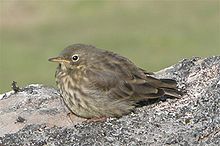Beach pipit
| Beach pipit | ||||||||||||
|---|---|---|---|---|---|---|---|---|---|---|---|---|

Beach pipit ( Anthus petrosus ) |
||||||||||||
| Systematics | ||||||||||||
|
||||||||||||
| Scientific name | ||||||||||||
| Anthus petrosus | ||||||||||||
| ( Montagu , 1798) |
The beach pipit ( Anthus petrosus ) is a passerine bird (Passeriformes) from the genus of the pipit ( Anthus ). It is very similar to meadow pipiters and mountain pipiters and is therefore easy to confuse with these species.
Morphology and characteristics
Beach pipit weigh about 20 to 30 grams and reach a body length of 16.5 cm. The wingspan is 23 to 28 cm. The beach pipit is compact and relatively bulky. The beak is strong, long and has a uniform black color. Depending on the season, the birds have different colors and patterns. In summer, the underside is yellowish to dirty white, dashed gray-brown. The back is olive-colored and darkly dashed out of focus. The tail is dark with gray sides. The quiet dress in winter is not so intense in his drawings. The underside is then matt gray, the back rather dark. It differs from the meadow and mountain pipit in its dark legs. It is also bigger than the meadow pipit. In contrast to the mountain pipit, it is more strongly dashed and the over-eye stripe is shorter and less pronounced in color. The flight of the beach pipit is characterized by a short sequence of wings flapping between the glide paths. The singing is trilling and the singing flight is very similar to that of the meadow pipit. The lure, however, is rougher and sharper.
distribution
The beach pipit occurs on the rocky coasts of Scandinavia , the north and west coasts of Great Britain , Iceland , Ireland , Russia and north- central Europe . The birds of the populations in Ireland, Great Britain and France are resident birds . The northern breeding animals move from September to December in more southerly regions, on the European Atlantic coasts to Gibraltar , northern Germany and Greece , as well as on the Algerian and Moroccan coasts. There they stay mainly on flat coasts with open sandy and shell beaches.
Way of life
Beach pipit lives solitary, but in winter they appear in small, loose groups. They are true to their location and usually do not stray far from their territory .
food
It feeds on flies (mainly seaweed flies), springtails , larvae , clams and small snails , which it finds on rocks, meadows and in the fringes of the beach. In summer he does not disdain the seeds of grasses .
Reproduction
The mating and breeding season extends from April to July. Both sexes show a conspicuous courtship flight, which is accompanied by trilling singing. The nest is created by the female on the ground, in caves, on rocks or on overgrown cliffs. It is cup-shaped, has a deep hollow and consists of grass and moss. It is lined with hair and plant matter. The female lays 3 to 6 dark-spotted eggs on a light gray background. There are usually two or three broods a year. The clutch is only incubated by the female, while the male guards the breeding area. The breeding period is about two weeks, the young are fed with insects and leave their nest after 15 days. They are self-employed when they are around four weeks old. The beach pipit can reach an age of up to five years in the wild.
Systematics
The species Anthus petrosus is divided into further subspecies by some authors . These are:
- Anthus petrosus petrosus ( Montagu , 1798) in Ireland, Great Britain and on the coasts of France
- Anthus petrosus meinertzhageni ( Montagu , 1798) in the Hebrides
- Anthus petrosus littoralis Brehm , 1823 in northwestern Europe and Scandinavia
- Anthus petrosus kleinschmidti Hartert , 1905 on the Faroe Islands
Duration
The worldwide population of the beach pipit is estimated at 230,000 to 580,000 individuals (BirdLife International in prep.) . The beach pipit is therefore not considered endangered and is given by the IUCN as Least Concern . The largest population is in Norway and is estimated to be over 100,000 specimens.
swell
Individual evidence
- ↑ http://www.bsc-eoc.org/avibase/avibase.jsp?ts=1221144777590&pg=search&qstr=Anthus+petrosus&qtype=2
- ↑ http://209.85.135.104/search?q=cache:d-LJKKB5mWgJ:www.thebirdsofsouthgloucestershire.co.uk/Birding%2520Lists/British%2520Forms.xls+www.thebirdsofsouthgloucestershire.co.uk/Birding%2520 .Lists/British % 2520Forms.xls & hl = de & ct = clnk & cd = 1 & gl = de ( page can no longer be accessed , search in web archives ) Info: The link was automatically marked as defective. Please check the link according to the instructions and then remove this notice.
literature
- Rob Hume: Birds in Europe . Dorling Kindersley Verlag, 2007 ISBN 978-3-8310-0991-6
- Erwin Stresemann: Excursion fauna Germany . Gustav Fischer Verlag Jena, 1995 ISBN 3-334-60951-0
- Volker Dierschke: Which songbird is that? Franckh-Kosmos Verlags-GmbH & Co. KG, Stuttgart 2006
- David Burnie: Fascination with the Wildlife . New Honos Verlag, Cologne
Web links
- Videos of the beach pipit
- An overview of the plumage of the beach pipit
- Birdlife international
- Anthus petrosus inthe IUCN 2013 Red List of Threatened Species . Listed by: BirdLife International, 2012. Retrieved September 21, 2013.
- Beach pipit's feathers

